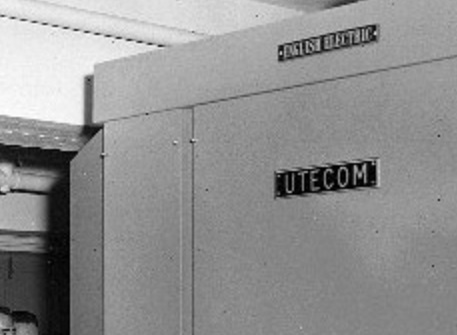Preamble
The Australian Computer Society (ACS) was formed 50 years ago, when the various state computer societies joined forces.
To mark the occasion, the ACS has initiated a heritage project to honour the many individuals who have contributed to the growth of the ICT profession in Australia.
At the heart of the project is a history of computing in Australia. It is not just a history of the ACS, but the history of a profession.
Australia has the longest computing history of any country, excepting the US and the UK, and CSIRAC in the Museum of Victoria is the oldest computer still in existence.
Previously published:
Chapter 1 -The start of Australia’s computing history
Chapter 2: The first Australian Computer Conference
Chapter 3: Harry Messel and the birth of SILLIAC
Chapter 5: SILLIAC and the Snowy Mountains Scheme
Chapter 6: UTECOM
At the same time Sydney University inaugurated SILLIAC, cross-town rival the NSW University of Technology unveiled its own computer, called UTECOM (University of TEchnology COMputer).
The university, which changed its name to the University of NSW in 1958, was established in 1949 by the New South Wales government in response to what it saw as a shortage of scientists and engineers, highlighted during World War II. The university established an Institute of Nuclear Engineering in 1954 with a grant of £125,000 from the state government, intended to examine the use of nuclear power.
An electronic computer was regarded as essential to the task, with the advantage that it could be used by others areas of the university. The head of the School of Electrical Engineering, Professor Rex Vowels, planned to build a large computing department, and the University Council decided in late 1954 to use some of the grant money to purchase a machine.
UTECOM was the fifth of 33 DEUCE computers manufactured by British computer company English Electric. DUECE was a contrived acronym for Digital Electronic Universal Computing Engine. It was an improved version of the ACE (Automatic Computing Engine) designed by British computer pioneer Alan Turing, who had built the Colossus electronic code-breaking machines used at Bletchley Park in World War II.
Alan Turing
Turing was an enigmatic figure, one of the most influential in the early history of computing. The Turing machine, a theoretical model of how computers work, is named after him. So is the Turing test, regarded as the criterion for true artificial intelligence.
He was born in London on 23 June 1912 and died two weeks short of his 42nd birthday at his home in Wilmslow in Cheshire. His death was almost certainly at his own hand, from cyanide poisoning. The coroner certainly believed so.
(Turing was a homosexual, and had been charged with twelve counts of ‘gross indecency’ in 1952. He lucidly defended his actions, which he did not deny, and was placed on probation provided he submit to ‘organo-therapy’, or chemical castration. He was granted a posthumous pardon in 2013.)
Turing’s wartime work remained secret for many years, though he was awarded an OBE in 1945. His work on cryptanalysis and the deciphering of German codes may have shortened the war by months, or even years. After the war he moved the National Physical Laboratory (NPL) in the London suburb of Teddington, where in early 1946 he submitted a detailed design for a stored program computer, the ACE.
Turing’s plans for the ACE were quite ambitious, but because his work during the war could not be disclosed for security reasons, his colleagues at the NPL doubted whether it could be built. There were long delays as Turing worked to convince others of the value of his design. In the meantime, the EDSAC team at the University of Manchester developed and released their machine.
Pilot Model ACE
Finally, the NPL decided to build a smaller version of Turing’s machine, which it called the Pilot Model ACE. It first ran on 10 May 1950. Its design was adopted and commercialised by English Electric, which called it the DEUCE.
The university set up an area which would house UTECOM, appointed Department of Electrical Engineering lecturer Ron Smart to manage it, and sent him to England for six months to study the design and maintenance of the machine. It was built at the English Electric manufacturing and research facility at Kidsgrove in Staffordshire. It was then tested, disassembled, and shipped to Australia., arriving on 1 August 1956. Smart’s experience and the machine’s solid design meant it was fully operational just a month later.
Its mercury delay line memory provided a memory of about 1.6 kilobytes. It had 1450 valves, with offline memory provide by a magnetic drum of 32 KB. The computer itself came by sea, but the fragile drum came by air – in its own seat.
UTECOM vs SILLIAC
On UTECOM’s opening day one of the most inquisitive attendees was John Bennett, eager to see how this off-the-shelf English machine compared to Sydney University’s SILLIAC. The two machines had very different design philosophies.
SILLIAC, based on the von Neumann architecture, was a parallel machine suited to data intensive applications. UTECOM, based on the Turing architecture, was a parallel machine that required detailed programming knowledge. It was more suited to what have come to be called compute-intensive applications.
Both machines were reliable by the standards of their day, and as general purpose machines were capable of being adapted to most jobs they were asked to do. The Sydney Morning Herald ran a large three-page supplement on the two machines on 12 September 1956, describing them in considerable detail. It was the first computer feature in any Australian newspaper.
.jpg)
The supplement makes fascinating reading, with articles on both SILLIAC and UTECOM. It covered the technology, the applications, and the people involved. But equally interesting were the advertisements, from STC, NCR, English Electric, British Tabulating Machine, Kalamazoo, IBM and Burroughs.
A ‘Layman’s Guide’ described the machines’ operations, and its uses in industry and commerce were outlined. “Welcome News – Drudgery Ended in Many Business Systems,” one headline optimistically predicted.
UTECOM was as popular with outside users as SILLIAC, but because it was shared across departments it had a higher proportion of university work.
The demise
Like SILLIAC, UTECOM had a long life, extended by a major upgrade in 1963. But valve computers were on the way out, with transistors becoming popular and magnetic core memory replacing the slower delay tubes and CRTs.
UTECOM was replaced by an IBM 360/50 in October 1966. This machine was 50 times faster than UTECOM, which was decommissioned in December 1966 and broken up for scrap. Only the drum, some memory tubes and a few racks of electronics were saved.
Veteran ICT journalist Graeme Philipson is researching and writing the Heritage Project book, which is due for release on the 50th anniversary of the formal incorporation of the ACS, on 3 October 2017.
The project also involves the creation of a ‘virtual museum’, cataloguing hardware and other artefacts, and collecting and curating documents on the history of the industry, including oral histories of as many people as possible.
Please get in touch with Graeme if you would like to contribute, at graeme@philipson.info










.jpg.transform/320x180/img.jpg)